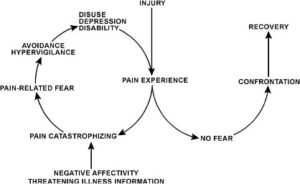Living with chronic musculoskeletal pain can be a challenging and overwhelming experience. It often affects various aspects of your life, making it difficult to perform daily activities and participate in the things you enjoy. As someone seeking relief from this pain, it is important to understand the role of fear of movement and avoidance behaviour in managing chronic musculoskeletal pain. In this blog post, we will explore these concepts and provide you with a guide to better navigate your journey towards pain management and improved well-being.

Figure 1. The Fear-Avoidance Model
The Fear-Avoidance Cycle
Chronic musculoskeletal pain can trigger fear and anxiety related to movement due to past painful experiences. This fear may lead to avoidance of certain activities or movements perceived as threatening. Unfortunately, this avoidance can reinforce the cycle of pain and disability, making it challenging to break free from its grip.
Recognising Your Fear and Avoidance
It is important to recognise any discrepancies between your self-reported fear of movement and your actual avoidance behaviour. Sometimes, individuals may experience high levels of fear while still engaging in activities or movements. Conversely, some individuals may avoid certain activities despite reporting lower levels of fear. Identifying these discrepancies can help you and your healthcare team tailor a personalised treatment plan to address your specific needs.
Assessing Your Fear and Avoidance
To gain a better understanding of your fear of movement and avoidance behaviour, healthcare professionals may use validated assessment tools such as the Tampa Scale for Kinesiophobia (TSK) and the Pain Catastrophizing Scale (PCS). These assessments can provide valuable insights into your pain-related fear, catastrophic thinking, and their potential impact on your daily functioning. By working with your healthcare team and discussing your results, you can collaboratively develop a comprehensive treatment plan.
Overcoming Fear and Avoidance
Reducing fear of movement and avoidance behaviour is essential for effectively managing chronic musculoskeletal pain. Gradual exposure therapy and cognitive-behavioural interventions are commonly used strategies to address fear-related barriers. These approaches involve gradually facing feared activities or movements in a safe and controlled manner while working on changing maladaptive beliefs and thoughts surrounding your pain. Educating yourself about the underlying mechanisms of pain can also empower you to take an active role in your recovery journey.
Embracing a Multidisciplinary Approach
Managing chronic musculoskeletal pain requires a multidisciplinary approach, involving a team of healthcare professionals such as physiotherapists, psychologists, pain specialists, and others. Working collaboratively with this team allows for a comprehensive and holistic approach to address the physical, psychological, and social aspects of your pain. The collective expertise of these professionals can provide you with the support, guidance, and resources necessary to effectively manage your pain and improve your overall well-being.
Understanding fear of movement and avoidance behaviour is vital for effectively managing chronic musculoskeletal pain. By recognising the role of fear and avoidance in your pain experience, assessing your own fears and behaviours, and collaborating with a multidisciplinary healthcare team, you can take proactive steps towards breaking the cycle of pain and regaining control over your life (Vlaeyen et al., 2023).
Remember, you are not alone in this journey, and with the right support and guidance, you can achieve improved pain management and overall well-being. So why don’t you book with Healthfix today and get started on your journey to improved well-being.
Reference:
Vlaeyen, J. W., Crombez, G., & Linton, S. J. (2023). Understanding Discrepancies in a Person’s Fear of Movement and Avoidance Behavior: A Guide for Musculoskeletal Rehabilitation Clinicians Who Support People With Chronic Musculoskeletal Pain. Journal of Orthopaedic & Sports Physical Therapy, 53(7), 360-362. doi: 10.2519/jospt.2023.11420.
Leeuw M, Goossens ME, Linton SJ, et al. The fear-avoidance model of musculoskeletal pain: current state of scientific evidence. J Behav Med. 2007;30(1):77-94.
By Caitlan Skillicorn, Senior Physiotherapist, APA Titled Sports and Exercise Physiotherapist
